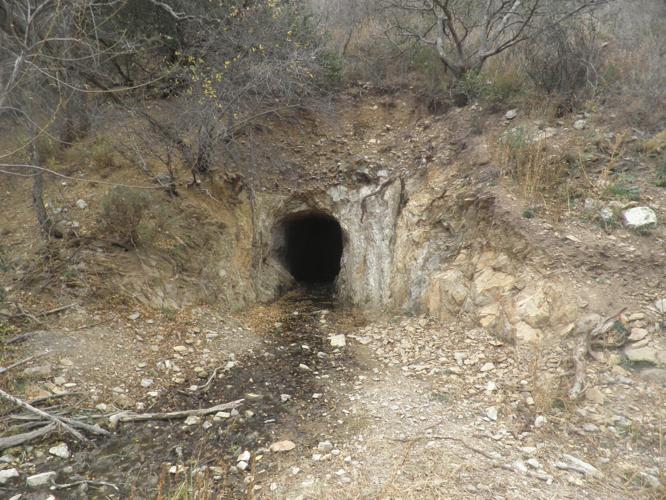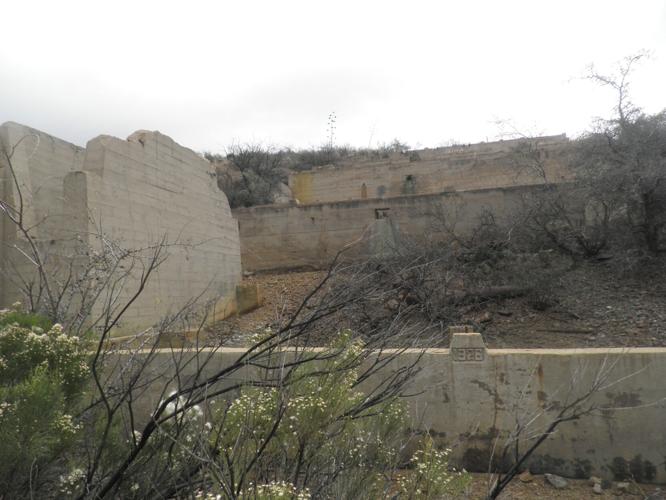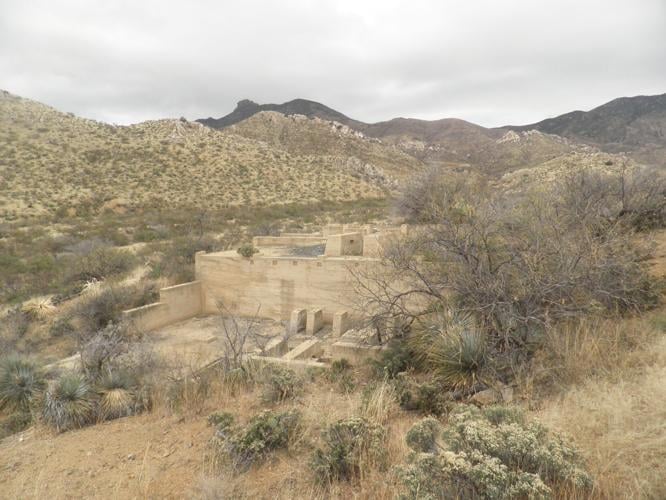Mining in the Dos Cabezas Mountains has a long and varied history of successes and failures based upon mineable resources, metal commodities and capital investment proportionate to the cost of ore extraction.
The northwestward-trending range in northeastern Cochise County is roughly 22 miles long and eight miles wide. In elevation, it reaches 8,354 feet with its two signature rock outcrops that give it its Spanish name Dos Cabezas (Two Heads).
Prospectors attracted by the gold-quartz veins and contact metamorphic copper deposits comprised of pre-Cambrian schist and granite have intermittently mined what became known as the Dos Cabezas Mining District on the southwest flank of the range.
Early gold discoveries during the mid-19th century occurred around Gold Gulch placers northwest of Dos Cabezas and near Apache Pass in the southeastern part of the range. Gold production from these deposits was intermittent with an estimated value of $182,000 by 1933.
The area was originally called Ewell Springs, beginning as a camp for the U.S. and Mexico boundary surveyor commission in 1851. In 1857 it served as a stage stop for the San Antonio and San Diego stage lines.
The town of Dos Cabezas, founded around 1878, is at the southwestern foot of the mountain range. By the 1880s, the town had more than 80 buildings including a stage stop for the National Mail and Transportation Co., three stamp mills, brewery, hotel, blacksmith shop, general store and school. It also had its own newspaper, “The Gold Note,” and gold bullion was exchanged at the local Wells Fargo Office.
John Casey is credited with establishing one of the earliest claims in the Dos Cabezas Mountains. Known as the Juniper Mine, and later as the Gold Ridge Mine, the mine saw little development because of Casey’s lack of financial capital, until it was acquired by local businessmen who formed the Chicago and Arizona Copper Co. in April 1903.
Thomas B. Chattman served as its president alongside investors W. F. Nichols, James J. Riggs and Pablo Soto. The mine was leased out over the next decade and was worked in 1917 by the Dos Cabezas Gold Ridge Mining Corp. While the mine was worked intermittently by lessees, by 1934 it was credited with production totaling $36,000.
The mines in the Dos Cabezas Mining District relied heavily on the town of Willcox (railstop for the Southern Pacific mainline), located 14 miles northwest of the mountain range, for ore shipment.

Hoist operation in Dos Cabezas circa 1920s.
The Mascot Copper Co. organized by Thomas N. McCauley in 1907 sensationalized its holdings, enticing an abundance of capital from investors lured by his false claims that great ore bodies had been discovered.
In 1915 the Mascot and Western Railroad was built from Willcox to the Mascot townsite near Dos Cabezas for ore haulage, which contributed greatly to the economies of both towns and the reputation of the Mascot mining property.
A 20-year lease to the American Smelting and Refining Co. was short-lived due to operational expenses, despite increased production and improvements. Lack of substantial high-grade ore, coupled with high overhead costs, necessitated reorganization by McCauley, and his company merged with the Mascot Mining Co., the Western Finance Co. and the Associated Copper Co. to form the Central Copper Co. in 1919.
By 1926 the mine employed 400 people who, with their families, gave the town of Dos Cabezas a population of 1,000.
That year saw further development including a new power plant, crusher and concentrator, along with an aerial tramway 10,600 feet long transporting ore from the Elma Mine on the north side of the Dos Cabezas Mountains. A battery-powered electric locomotive was employed as a replacement for horses hauling ore from the Consolidated Tunnel.
Operations were short-lived as the mineral market declined the following year, necessitating cuts in production and an overall decline in mining output. Production that year was 1,692 tons of ore yielding 60,515 pounds of copper, 1,339 ounces of silver and 16 ounces of gold.

Horse and miners conducting underground mining operations in the Consolidated Tunnel at the Mascot Mine circa 1920s.
During several decades of operation total production of the Mascot and Central Copper companies was 3,500,000 pounds of copper and silver valued at time-period estimates of $750,000.
Nearby Gold Prince, Le Roy and Dives mines also have a history of production. The Gold Prince Mine was first named the Murphy Mine in 1878 and was mined by T. C. Bain intermittently for high-grade ore the following decade. The mine was further developed by the Gold Prince Mining Co., including 3,000 feet of workings and a 25-ton mill in the years proceeding World War I.
Consisting of a series of lenticular bodies of grey quartz comprised of gold and iron pyrite, these were formed by the filling of openings along fissures from deposition caused by ascending hydrothermal solutions.
During Phelps Dodge Corp. ownership from 1984 through 1986, 14,238 metric tons containing 9.74g/t Au and high purity (80% or greater silica) vein quartz were extracted, destined for flux to their smelters in Douglas and the Hidalgo smelter 120 miles away in Playas, New Mexico.

Upper Power Plant belonging to the Central Copper Co. with plant employees in the background.
Queenstake Resources USA Inc. leased the property during the following six years, using mining equipment purchases from Phelps Dodge and further developing the property through drilling and extension of mine workings.
Western States Mining Corp bought the property in 1993, though little production had occurred when it shut down in the mid-1990s. Overall, total production from the Gold Prince Mine is said to have been 22,000 ounces of gold.
The Le Roy Mine 1.5 mile northeast of Dos Cabezas, located in 1878, produced several thousand tons of gold-silver-lead ore. Underground workings of the Leroy and Climax claims included a small onsite mill along with 300-foot-deep inclined shafts and several thousand feet of workings accessing a stringer gold load of up to five feet wide. Production included 550,000 pounds of lead and $40,000 worth of gold through 1933.
The Dives Mine is notable for having produced over $20,000 in gold during 1911-1914. The Dives Mining Co. built a 10-stamp amalgamation-concentration mill on the property. After the decline of the Mascot Mine in the late 1920s, the Consolidated Gold Mines Co. worked the property, building a 50-ton flotation mill onsite. The mine is credited with an output of around $35,000 worth of gold shipped in 1935; operations were suspended three years later.
The U.S. Borax and Chemical Corp. unsuccessfully conducted exploration during the mid-1970s near the Mascot and Elma Mines for a deeply buried porphyry copper deposit, using indicators such as the surface exposure of copper-bearing massive sulfides and the presence of breccia pipes of certain types of porphyritic rock.
Other mineral findings in the Dos Cabezas Mountains found in stream-sediment and rock chip samples include tungsten, bismuth and fluorite, along with uranium found on radioactive quartz-fluorite veins.
Mineral exploration and mine development will no doubt continue around Dos Cabezas for the foreseeable future as geologists study the ore deposition resulting from the complex geology of the range.

Dos Cabezas Mountains from the vantage point of the Willcox Playa in the Sulphur Springs Valley.

Open adit around the Leroy Mine Group.

Remnants of the crusher and concentrating facility built by the Central Copper Co. in 1926 (engraved in foreground) as seen in 2014.

View of the surrounding topography around Central Copper Co.’s ore concentrating facility in the Dos Cabezas Mountains circa 2014.

Concrete Labyrinths acting as water catchments as seen with the Central Copper Co.’s ore concentrating facility in the Dos Cabezas Mountains circa 2014.













